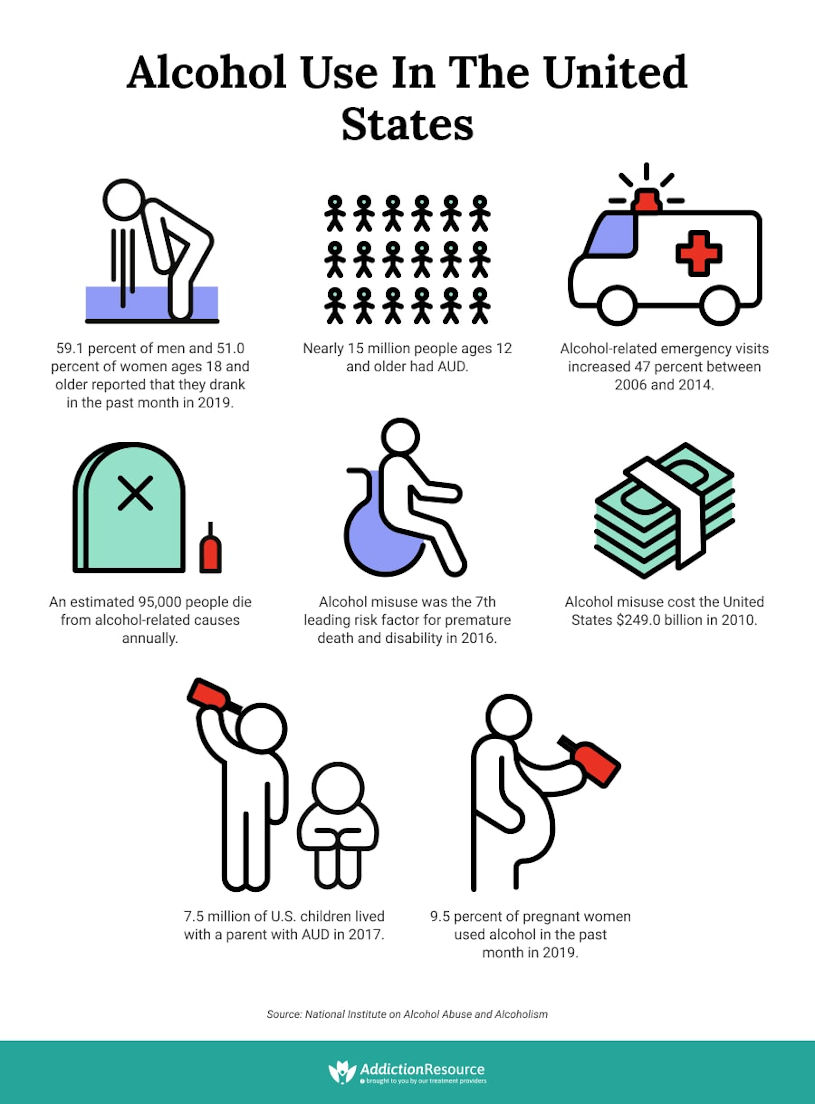Alcohol use is prevalent in society, and for many, it can be a moderate and enjoyable part of social gatherings or celebrations.
Nevertheless, alcohol drinking can become a serious health concern when individuals fail to control their intake, leading to alcoholic beverage dependency. The Alcohol-Related Disease Impact application estimated over 140,000 deaths in the United States alone, placing alcohol disorder as one of the leading preventable causes of death.
Unfortunately, this statistic is on the rise, with a notable 25.5% increase in alcohol-related deaths recorded between 2019 and 2020. Yet, as the keyword for alcohol disorder is “preventable,” early intervention is crucial to help those in need. Read on to understand alcohol addiction, its signs, and treatment options.
Table of Contents:
What is Alcoholism?
Alcoholism, professionally referred to as Alcohol Use Disorder (AUD), is a chronic and potentially severe medical condition characterized by an individual’s compulsive and problematic pattern of alcohol consumption.
This disorder encompasses a range of symptoms, including an inability to control drinking, continued use despite negative consequences, and a diminished ability to recognize the harmful effects of alcohol on personal, social and professional aspects of life.
The Diagnostic and Statistical Manual of Mental Disorders, Fifth Edition (DSM-5) outlines AUD criteria, categorizing it from mild to severe based on symptom count. Criteria include unsuccessful control attempts, significant time on alcohol, and prioritizing it over essential responsibilities.
4 Stages of Alcohol Abuse
The progression from occasional alcohol use to alcohol addiction doesn’t happen overnight.
Recognizing the stages in transitioning from alcohol use to disorders is crucial for strategically timing risk reduction interventions and mitigating the impact of alcohol-related harm. Several studies have delved into the factors linked to transitions across alcohol abuse stages—initial use, regular use, disorders, and remission from disorders.
1. At-Risk Stage:
This stage occurs during social or stress-relief drinking, potentially leading to alcohol tolerance. Regular exposure at this stage may gradually escalate into a riskier consumption pattern.
2. Early Alcohol Use Disorder:
Progression involves blackouts, solitary or secretive drinking and heightened fixation with alcohol. Individuals may find themselves increasingly reliant on alcohol to cope with stressors, indicating an early stage of dependency.
3. Mid-Stage Alcohol Use Disorder:
At this point, alcohol consumption spirals out of control, impacting daily life and manifesting in work, family, financial and health challenges. Visible organ damage on tests underscores the severity of the disorder.
4. End-Stage Alcohol Use Disorder:
Drinking becomes the predominant focus, eclipsing essential elements such as food, intimacy and well-being.
This stage is marked by overwhelming despair, severe complications arising from organ damage, alcoholic liver disease and the threat of death.
Warning Signs of Alcoholism
This table provides an overview of the key symptoms and signs associated with Alcohol Use Disorder (AUD). It’s safe to remember that AUD is not confined to any specific demographic, affecting individuals across age, gender, and socio-economic lines.
| SYMPTOM / SIGN | DESCRIPTION |
|---|---|
| Loss of Control | Inability to limit or stop drinking despite adverse consequences. |
| Tolerance: | More alcohol is needed to achieve the desired effect. |
| Withdrawal Symptoms | Experiencing physical or psychological symptoms such as anxiety, irritability, and nausea when not drinking. |
| Neglecting Responsibilities | Continued alcohol use despite the negative impact on work, family or health. |
| Loss of Interest | Drinking becomes a central focus, excluding other interests. |
| Drinking Alone or in Secret | Consuming alcohol alone becomes a regular behavior. |
| Unsuccessful Attempts to Quit or Cut Down | Repeated unsuccessful efforts to cut down or quit drinking. |
| Time Spent Obtaining or Recovering from Effects | Significant time spent obtaining, using, or recovering from the effects of alcohol. |
| Continued Use Despite Knowledge of Harm | Continued use despite knowledge of physical or psychological harm. |
| Social or Interpersonal Problems | Strained relationships with family, friends or colleagues, conflicts arising from alcohol-related behavior. |
Health Risks Associated with Alcohol Addiction
Heavier alcohol consumption is a significant risk factor for numerous health issues, making it a major contributor to the global burden of disease. Alcohol disorder is an underlying cause of over 30 conditions, listed in WHO’s International Classification of Diseases, 10th Edition (ICD–10), and contributes to the development of many others.
The subsequent list outlines the primary disease and injury categories influenced by alcohol consumption:
- Infectious disease
- Cancer
- Diabetes
- Neuropsychiatric disease
- Cardiovascular disease
- Liver and pancreas disease
- Unintentional and intentional injury
Who is at Risk of Alcoholism?
It is crucial to acknowledge that everyone can be at risk of alcohol addiction at some point in life. Sympathy and support are paramount for those struggling with alcohol abuse.
Studies show that alcohol abuse and alcoholism present substantial health concerns for men and women. While men exhibit a higher prevalence of alcoholism, women experience a heightened risk of alcoholism-related bodily harm.
Certain groups are more prone to chronic alcoholism than others. These individuals include:
- Family history of alcoholism or substance abuse.
- Those with certain genetic predispositions.
- Individuals with mental health disorders.
- Early onset of drinking, especially during adolescence.
- Peer pressure, particularly in groups where heavy drinking is prevalent.
- Individuals experiencing trauma or high levels of stress.
- Lack of a strong support system.
- Personality traits such as impulsivity or sensation-seeking.

Treatment Strategies for Alcoholism
Nationwide, alcoholism treatment and rehabilitation centers, staffed by specialized medical professionals, offer comprehensive assistance—from detox and counseling to therapy and a successful post-rehabilitation life free from alcohol-related issues.
Alcohol Detox
The initial and challenging phase of recovery involves professional substance detox to help manage harsh alcohol withdrawal symptoms. Healthcare providers monitor progress and may administer medications to ease pain during the withdrawal period, which can last a week or more.
Alcohol Treatment Programs
Varied programs, including private or government-funded options, are offered outpatient or inpatient. After detox, ongoing treatment involves counseling sessions and diverse therapeutic approaches, i.e., family counseling, Alcoholics Anonymous (A.A.), and rehab residential facilities.
Rehabilitation Therapies
Techniques such as Cognitive-Behavioral Therapy (CBT), Contingency Management Therapy, and Motivational Enhancement Therapy aim to control drinking urges and prevent relapse.
Medications for Alcohol Addiction
Prescription medications, including Acamprosate, Naltrexone, and Disulfiram, help manage withdrawal symptoms and ongoing physical aspects of addiction.
What is Alcoholism? Final Considerations
Overcoming Alcohol Use Disorder (AUD) demands a comprehensive, individualized approach.
Essential components include critical training for daily life transition, robust support structures, and personalized relapse prevention. Recognizing AUD’s complexity, influenced by genetics, environment and psychology, underscores the importance of seeking professional help—be it counseling, therapy, or support groups.
Early intervention is crucial to halt progression, emphasizing the need for effective, tailored treatment and lasting recovery.
People Also Ask
What is the definition of alcoholism?
Alcoholism is a chronic disorder characterized by an inability to control or stop alcohol consumption despite adverse consequences, often leading to physical and psychological dependence on alcohol.
What are the 5 types of alcoholic?
A comprehensive study by NIAAA, NIH, and NESARC identified five subtypes of alcoholics: Young Adult, Functional, Intermediate Familial, Young Antisocial, and Chronic Severe. These categories consider age, family history, mental health conditions and substance abuse.
What are the 5 A’s of alcoholism?
The 5 A’s of alcoholism intervention are:
- Ask (identify risk factors)
- Assess (evaluate multiple risks, readiness to change, health literacy)
- Advise/Agree (provide tailored information, use motivational interviewing, set goals)
- Assist (refer to intensive intervention)
- Arrange (ensure follow-up and maintenance).
Page Sources
- Nehring, S. M., Chen, R. J., & Freeman, A. M. (2023, August 8). Alcohol Use Disorder. StatPearls - NCBI Bookshelf. https://www.ncbi.nlm.nih.gov/books/NBK436003/
- Alcohol Use Disorder: A comparison between DSM–IV and DSM–5 | National Institute on Alcohol Abuse and Alcoholism (NIAAA). (n.d.). https://www.niaaa.nih.gov/publications/brochures-and-fact-sheets/alcohol-use-disorder-comparison-between-dsm
- Rapsey, C. M., Wells, J. E., Bharat, M. C., Glantz, M., Kessler, R. C., & Scott, K. M. (2019). Transitions Through Stages of Alcohol Use, Use Disorder and Remission: Findings from Te Rau Hinengaro, The New Zealand Mental Health Survey. Alcohol and Alcoholism (Oxford, Oxfordshire), 54(1), 87-96. https://doi.org/10.1093/alcalc/agy069
- Patel, R., & Mueller, M. (2023, July 13). Alcoholic liver disease. StatPearls - NCBI Bookshelf. https://www.ncbi.nlm.nih.gov/books/NBK546632/
- Garbutt, J. C. (2008). Alcoholism. In Humana Press eBooks (pp. 227–249). https://doi.org/10.1007/978-1-59745-252-6_14
- Rehm, J. (2011). The Risks Associated With Alcohol Use and Alcoholism. Alcohol Research & Health, 34(2), 135-143. https://www.ncbi.nlm.nih.gov/pmc/articles/PMC3307043/
- Ceylan-Isik, A. F., McBride, S. M., & Ren, J. (2010). Sex Difference in Alcoholism: Who is at a Greater Risk for Development of Alcoholic Complication? Life Sciences, 87(5-6), 133. https://doi.org/10.1016/j.lfs.2010.06.002
- Researchers identify alcoholism subtypes | National Institute on Alcohol Abuse and Alcoholism (NIAAA). (2007, June 28). https://www.niaaa.nih.gov/news-events/news-releases/researchers-identify-alcoholism-subtypes

 Authored by
Authored by  Reviewed by
Reviewed by 
